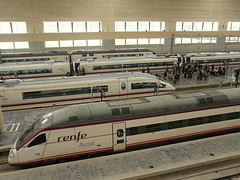Without having a national U.S. transportation policy, we miss many opportunities
Flickr photo by Marlis1 of Ave and Avant trains at the Zaragosa railroad station, She writes:
The Madrid-Zaragoza-Barcelona line was inaugurated on 20 February 2008, after parts of the line had operated since 2003 (Madrid-Zaragoza-Lleida) and 2006 (Lleida-Taragona). Seventeen trains run now every day between 6:00 and 21:00 hrs. This line is currently one of the world's fastest long-distance trains in commercial operation, with non stop trains covering the 621 km (386 mi) between the two cities in just 2 hours 38 minutes, and those stopping at all stations in 3 hours 23 minutes.
The Guardian has an article about the success of Spain's new system of high speed passenger railroad services. See "Spain's high-speed trains steal passengers from airlines." From the article:
SPAIN’S SLEEK new high-speed trains have stolen hundreds of thousands of passengers from airlines over the past year, slashing carbon emissions and marking a radical change in the way Spaniards travel.
Passenger numbers on domestic flights fell 20 per cent in the year to November as commuters and tourists swapped cramped airline seats for the space and convenience of the train, according to figures released yesterday.
High-speed rail travel – boosted by the opening of a line that slashed the journey time from Madrid to Barcelona to two hours 35 minutes in February – grew 28 per cent over the same period, with about 400,000 travellers switching from air travel to the 340km/h (220mph) AVE trains...
Two routes, from Barcelona to Malaga and Seville, opened last week. Lines are also being built to link Madrid with Valencia, Alicante, the Basque country and Galicia. The government has promised to lay 10,000km of high-speed track by 2020 to ensure that 90% of Spaniards live within 30 miles of a station. The prime minister, José Luis Rodríguez Zapatero, boasts it will be Europe's most extensive high-speed network.
High-speed rail tickets are often cheaper. The lowest one-way price on the 410-mile Barcelona-Madrid route this month is €44 (£40). Rail operator Renfe says 99% of trains on the route arrive on time.
A national transportation policy would look at oil usage, carbon emissions, cost, and efficiency and make optimal transportation decisions accordingly.
I am about to start reading the Earthscan book Transport Revolutions: Moving People and Freight without Oil, and given all the hullaballoo about the "stimulus" and its focus on road building rather than transit, the experience in Spain in repatterning their transportation system is particularly interesting.

Labels: transportation planning




0 Comments:
Post a Comment
<< Home